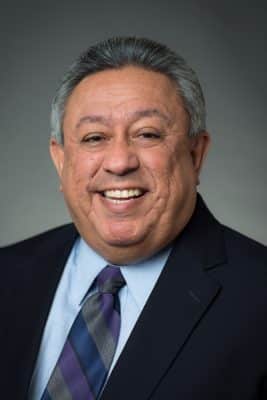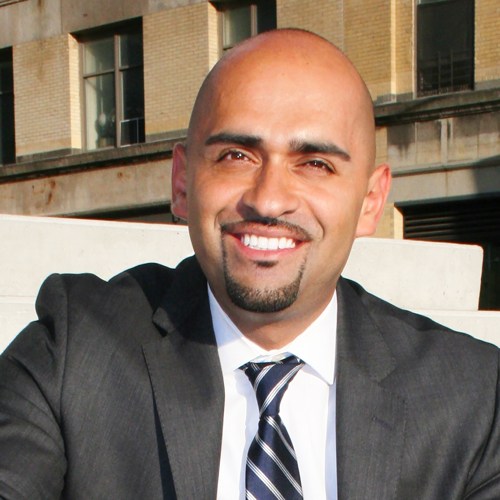
Juan Ontiveros isn’t afraid of hiring people who are smarter than him. It’s a humble position for someone who is regularly handed multimillion-dollar infrastructure projects from his employer, the University of Texas–Austin.
The university’s associate vice president of utilities, energy, and facilities management is a mechanical engineer by training and is known for taking a visionary, holistic approach to his projects—all of which have achieved energy efficiencies copied by other university campuses across the world. He didn’t accomplish any of these successes by himself, he notes. He manages people who manage other people and projects to deftly execute a clean-energy mission.
That mission is to cool, heat, and power the fifth-largest university campus in the United States, with a population of 50,000 students and 21,000 faculty and staff. More to the point, Ontiveros’s mission is to provide these services with reliability and efficiency—including in a few 100-year-old buildings that aren’t conducive to either of those things.
To manage all this—and to convince school administrators to spend tens of millions of dollars now to save money over time—Ontiveros has to trust cost-benefit projections, the people reporting to him, and his own instincts. “I’m a risk-taker,” he says. “My staff have to be comfortable with that, and they have to let their teams take some risks, too.”
Pay Now, Save Later
The UT-Austin campus has thirteen LEED-certified buildings, with five more certifications pending. Part of what Ontiveros’s team did was to bring the use of older buildings into an era of green-driven efficiency.
In a state where fossil fuels define much of the economy, the work they’ve done to reduce the use of oil and gas is remarkable. There are solar arrays on three of the 150 buildings on the campus (with a capacity of 446 kilowatts, less than 5 percent of the total demand), so the legacy of the campus’ district energy system means the school’s buildings are fueled by natural gas.
District energy essentially means the campus generates its own power with its own on-site plant; UT–Austin has had a district system since 1929. But Ontiveros’s career started at UT–El Paso, a sister campus where he earned both his bachelor’s and master’s degrees, and where the buildings were on the local utility grid.
That posed an initial challenge for Ontiveros. “We were at a point where we needed to replace or expand existing systems,” says Ontiveros, who served in a similar capacity as UT–Austin while at UT–El Paso in the early 1990s. “I saw that gas prices were low, yet utility electrical prices were high. So I looked at it on a higher level.”
The solution at that time was to first talk to the utility about reducing their rates. The UT–El Paso campus was 10 percent of the utility’s customer market, so they eventually, with persuasion, were willing to talk. The negotiation effectively reduced the price by about 40 percent, saving the campus about $1.2 million.
With those savings, Ontiveros was able to build a central plant at modern standards that accommodated the growing campus. Then, using an energy performance contract, they financed the construction based on anticipated cost savings that were based on a ten-year return on investment for the facility. The plant outperformed expectations, delivering a return on investment within just six years.
When Ontiveros was offered the job at the Austin campus in 1997, the flagship institution of the fourteen-campus UT system, he jumped at the opportunity. Austin is a bigger campus with budgets and responsibilities on a much larger scale, but Ontiveros is not one to shy away from a challenge. “I rarely say no to anything,” he says.
Two years after Ontiveros arrived in the Texas capital, a large boiler erupted and resulted in an emergency $2 million expense. “It was a sign of problems to come,” he recalls. Concurrently, the Austin campus added several buildings—five million square feet—placing a higher demand for power and cooling. So, Ontiveros proposed capital improvements that would cost $48 million. He successfully sold those projects on the basis of how much money could be saved moving forward.
Through a combination of upgrading and building a new substation, a cooling tower, steam and gas turbines, chilling stations, and a water-heating plant—in some cases, using waste heat from one process to power other components of the system—the UT–Austin campus now runs at about half the cost of comparable systems elsewhere. All told, he has overseen more than $240 million in projects.
Knowledge Is Power
Ontiveros has a reputation for being a “yes-man” in all areas of his life, including furthering his education. He completed his master’s thesis on solar energy systems in the 1970s. He has always had a keen interest in renewable fuels. Since then, he has had to continue his education to keep up with the ways in which traditional technologies have evolved considerably, even if the buildings and district systems are largely locked into place. Upgrades, retrofits, and new facilities have reduced overall consumption of traditional [natural gas] energy sources.
Now, the mechanical engineer seems to know a lot about human psychology as well. By making academic departments and students aware of their cost on the university’s district grid, he’s working to motivate them to reduce energy consumption room by room, building by building.
“Power plants on campus are invisible to most students,” he says. “But when students and faculty learn that the plants lower costs, which can affect tuition, they become a source of pride.”
First of Its PEERs
Juan Ontiveros’s modernization achievements at the UT–Austin district heating plant go beyond energy efficiencies. Even while bringing natural gas use by volume back to 1976 levels, the total campus space grew
80 percent in square footage. But in thirsty Texas, which has been faced with epic droughts in recent years, the use of potable water was cut by 66 million gallons by using “auxiliary water,” a part of which is condensate harvested from air-cooling systems. UT–Austin’s system is the first university certified by the US Green Building Council’s Performance Excellence in Electricity Renewal (PEER) program.

